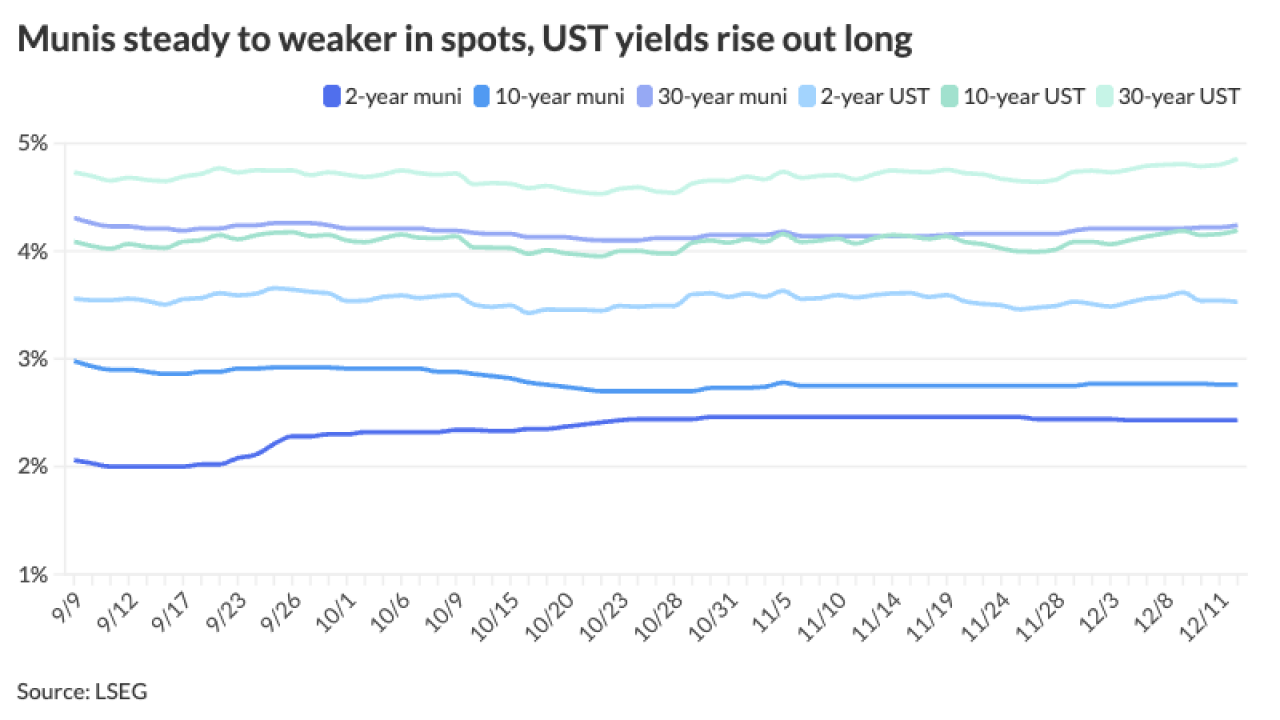In a recent paper, '
In a typical 'high-to-low' transaction, the municipality issues refunding bonds at a lower yield, and invests the proceeds in an escrow of Treasury securities that defease the cashflows of the not-yet-callable outstanding bonds to the initial call date. The outstanding bonds are effectively taken off the issuer's books and they are paid off on the call date. The transaction results in immediate cashflow savings; in fact, it is sometimes motivated by short-term budgeting problems, as noted by the authors. When Treasury rates are sufficiently high, the return on the escrow can match the municipality's long-term borrowing cost, effectively resulting in a windfall for the issuer (this is obviously not possible for corporate borrowers).
The stunning revelation of the academic study under review is that advance refunding can never be optimal. The authors claim that waiting until the call date is always preferable (possibly with a swap transaction that moves cashflows around but has zero net present value). If correct, this assertion may have far-reaching consequences for municipal finance.
Leonard Weiser-Varon, a municipal bond counsel, presented a
Having made an attention-grabbing claim, the authors invoke some fancy mathematics to 'prove' it, ensuring that reality doesn't intrude. For example, they seem to be confused about the basic mechanics of advance refunding. On page 11 they assert that when comparing waiting to the call date and advance refunding, the "payoffs up to the call date are identical." Not so: as mentioned above, the cashflow savings commence at the time of the transaction.
The authors' principal objection to advance refunding is that the issuer commits to calling even if interest rates subsequently rise, and this causes a "destruction of value." One would certainly not want to call a bond whose value is less than par, but the requirement to call is only one piece of the refunding process. By focusing on this aspect of the transaction, the authors are barking up the wrong tree. They miss the main point of an advance refunding — it locks in savings no matter how interest rates evolve subsequently.
It does not follow from the commitment to call that advance refunding is suboptimal. Consider a typical transaction: both the outstanding and the refunding bonds bear 5% coupons, but the size of the refunding issue is smaller and therefore the new debt service is lower. Let's fast forward to the call date, and assume that rates have risen significantly. According to our academic friends, the issuer should now experience 'refunder's remorse', because now it is committed to calling the old bonds. In this scenario the 'never advance refund' recommendation by the authors would have indeed resulted in no erosion of what they refer to as the 'option not to call'. Unfortunately, it would have also resulted in no savings whatsoever, a consideration that the authors fail to take into account. Incidentally, Mr. Weiser-Varon makes a similar point.
While the study emphasizes the risk of rising rates, practitioners are concerned with risk of rates declining after advance refunding, in which case more could have been saved by waiting. This is precisely why issuers should take a true option-based approach to the refunding decision (such as in the Massachusetts
In terms of academic standards for citing the literature, it is disconcerting how the authors misrepresent my position on advance refunding in order to support their claim. For example, on page 10, they say, " Kalotay and May recognize that efficiency must be less than 100% "; in fact what we say is "Efficiency from a formal option exercise cannot exceed 100%." The difference between 'must be less than' and 'cannot exceed' should be obvious.
The authors also assert that Kalotay and May "advocate an advance refunding for an efficiency level of 90%." What we said was that "We would consider 90 percent efficiency the minimum acceptable level."
The distinction between advocating refunding at 90 percent efficiency and suggesting that as the minimum acceptable level is not particularly subtle; we leave it to the reader to guess at a motive for the intentional distortion. Contrary to the authors' claim, under favorable conditions 100% efficiency is certainly achievable. Acting at a 90% efficiency may be justified by risk aversion: a bird in hand is worth two in bush. As a practical matter, the director of finance of a municipality may be hard-pressed to explain to the taxpayers why a bond issue was not refunded when there were savings to be had. Of course, the authors are free to think the world is risk-neutral — they have no skin in the game.
The paper also cites Kalotay and May as saying, " efficiency is 100% only in the case of no uncertainty " There is nothing in our paper even remotely suggesting this, and I can assure the authors that we would never make such an absurd statement.
I have indeed been a strong proponent of capturing a high percentage of the forfeited option value when refunding, and my firm has provided gratis the technology behind the
There is undoubtedly considerable waste from inefficient advance refundings, but let's not throw out opportunities to save taxpayers' money, when warranted, by giving credence to half-baked theories based on shoddy scholarship. The authors should descend from their ivory tower, make an effort to understand the real world, and revise their opus accordingly. They will be in the perfect position to complement their 'Practitioner Misconceptions' section with one on 'Academic Misconceptions.'
Andrew Kalotay, president of Andrew Kalotay Associates, is a leading authority on institutional debt management and fixed-income valuation.





